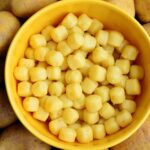Better Batter Gluten Free Flour Recipe: Gluten-free diets have gained significant attention in recent years, with more individuals seeking alternatives to traditional wheat-based products. For those with celiac disease, gluten sensitivity, or a preference for gluten-free options, finding a reliable gluten-free flour blend is essential. Better Batter Gluten-Free Flour is a popular option that has garnered praise for its versatility and performance in gluten-free baking. In this comprehensive guide, we will explore the nutrition and ingredients of Better Batter Gluten-Free Flour to check in 2023. Let’s delve into the details of this flour blend and understand its nutritional value.
What is Better Batter Gluten-Free Flour?
Better Batter Gluten-Free Flour is a proprietary flour blend created specifically for gluten-free baking. It is designed to mimic the texture and performance of all-purpose wheat flour, making it an ideal substitute in various recipes. The blend is free from gluten, wheat, dairy, nuts, soy, and other common allergens, making it suitable for individuals with various dietary restrictions.
Ingredients
The precise ingredients of Better Batter Gluten-Free Flour may vary slightly, but the blend typically includes a combination of the following:
- Rice Flour (white or brown)
- Tapioca Starch
- Potato Starch
- Potato Flour
- Xanthan Gum (for binding)
The specific proportions of these ingredients in the blend are what contribute to the flour’s performance in gluten-free baking.
Nutritional Composition
To check the nutritional composition of Better Batter Gluten-Free Flour in 2023, we will examine the typical macronutrient and micronutrient values per serving (100 grams) of the flour. Please note that nutritional information may vary depending on the specific batch and formulation of the product, so it’s essential to refer to the product packaging or the manufacturer’s website for the most up-to-date information.
Macronutrients (Per 100g)
1. Calories: The calorie content of Better Batter Gluten-Free Flour is typically around 350 to 380 calories per 100 grams. However, this value may vary slightly based on the specific formulation.
2. Carbohydrates: As a gluten-free flour blend, Better Batter primarily consists of carbohydrates. The total carbohydrate content is usually around 82 to 85 grams per 100 grams of flour.
3. Protein: Gluten-free flours generally have lower protein content compared to wheat flour. Better Batter Gluten-Free Flour typically contains about 1 to 2 grams of protein per 100 grams.
4. Fat: The fat content in Better Batter is relatively low, with around 0.5 to 1.5 grams per 100 grams of flour.
5. Fiber: Better Batter Gluten-Free Flour contains dietary fiber, which aids in digestion. The fiber content is usually around 1 to 2 grams per 100 grams.
Micronutrients (Per 100g)
1. Iron: Iron is an essential mineral that plays a crucial role in transporting oxygen in the body. Gluten-free flours, including Better Batter, may contain small amounts of iron.
2. Calcium: Calcium is essential for maintaining strong bones and teeth. Some gluten-free flours may contain traces of calcium.
3. Potassium: Potassium is an important mineral for heart health and maintaining proper fluid balance in the body.
4. Vitamin B6: Vitamin B6 is involved in various metabolic processes in the body, including protein metabolism.
5. Magnesium: Magnesium is important for muscle function and nerve transmission. Some gluten-free flours may contain small amounts of magnesium.
Allergens and Sensitivities
Better Batter Gluten-Free Flour is specifically formulated to be free from common allergens, including gluten, wheat, dairy, nuts, and soy. It is also free from artificial preservatives and additives. However, individuals with specific sensitivities or allergies should always check the product packaging or consult the manufacturer to ensure there are no cross-contamination risks or other potential allergens in the manufacturing facility.
Baking and Cooking with Better Batter Gluten-Free Flour
Better Batter Gluten-Free Flour is prized for its versatility, and it can be used as a one-to-one substitute for wheat flour in most recipes. Baking with gluten-free flour blends may require some adjustments to achieve optimal results. Here are some tips for using Better Batter Gluten-Free Flour in your baking and cooking:
- Xanthan Gum: The presence of xanthan gum in the blend acts as a binder and provides structure to baked goods. However, if your recipe calls for additional xanthan gum, you may need to reduce the amount or omit it altogether to avoid an overly gummy texture.
- Liquid Ratio: Gluten-free flours may absorb more liquid than wheat flour. Adjust the liquid ratio in your recipes as needed to achieve the desired consistency. This may involve adding more liquid or reducing the amount of flour used.
- Baking Time and Temperature: Gluten-free baked goods may require slightly different baking times and temperatures than recipes that use wheat flour. Keep a close eye on your baked goods and test for doneness with a toothpick or cake tester.
- Texture: Gluten-free flours can yield slightly different textures than wheat flour. Expect a slightly lighter and more delicate texture in your baked goods.
- Mixing and Blending: When working with Better Batter Gluten-Free Flour, mix and blend the ingredients thoroughly to ensure even distribution and a cohesive batter or dough.
Conclusion
Better Batter Gluten-Free Flour is a versatile and convenient option for those seeking gluten-free alternatives in their baking and cooking. It offers a one-to-one substitution for wheat flour in most recipes, making it easy to adapt traditional dishes to gluten-free versions. With a carefully crafted blend of rice flour, tapioca starch, potato starch, potato flour, and xanthan gum, Better Batter provides a consistent and reliable performance in gluten-free baking.
As with any dietary change, it’s essential to read the product packaging and ingredient list to ensure that Better Batter Gluten-Free Flour meets your specific dietary requirements and preferences. Always check for allergen information and potential cross-contamination risks if you have specific sensitivities or allergies.
In conclusion, Better Batter Gluten-Free Flour remains a top choice for gluten-free baking, and its continued popularity suggests that it will continue to be a staple in gluten-free kitchens in 2023 and beyond. Its reliability, versatility, and performance make it a valuable addition to the pantry for those embracing a gluten-free lifestyle or seeking delicious gluten-free alternatives in their culinary endeavors.



